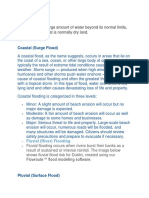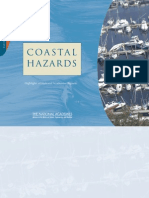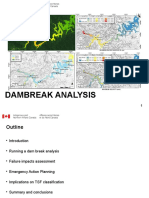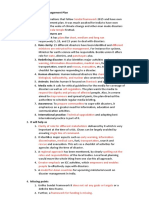Impacts of Flooding
Impacts of Flooding
Uploaded by
Miguel VillaluzCopyright:
Available Formats
Impacts of Flooding
Impacts of Flooding
Uploaded by
Miguel VillaluzOriginal Description:
Original Title
Copyright
Available Formats
Share this document
Did you find this document useful?
Is this content inappropriate?
Copyright:
Available Formats
Impacts of Flooding
Impacts of Flooding
Uploaded by
Miguel VillaluzCopyright:
Available Formats
Impacts of flooding
Floods cause more than $40 billion in damage worldwide annually, according to the Organization for Economic Cooperation and Development.
In the U.S., losses average close to $8 billion a year. Death tolls have increased in recent decades to more than 100 people a year. In China's
Yellow River Valley some of the world's worst floods have killed millions of people.
When floodwaters recede, affected areas are often blanketed in silt and mud. The water and landscape can be contaminated with hazardous
materials such as sharp debris, pesticides, fuel, and untreated sewage. Potentially dangerous mold blooms can quickly overwhelm water-soaked
structures.
Residents of flooded areas can be left without power and clean drinking water, leading to outbreaks of deadly waterborne diseases like typhoid,
hepatitis A, and cholera. (Learn here about flood preparation and safety tips.)
Flood prevention
Flooding, particularly in river floodplains, is as natural as rain and has been occurring for millions of years. Famously fertile floodplains such as
the Mississippi Valley, the Nile River Valley in Egypt, and the Tigris-Euphrates in the Middle East have supported agriculture for millennia
because annual flooding has left tons of nutrient-rich silt deposits behind. Humans have increased the risk of death and damage by increasingly
building homes, businesses, and infrastructure in vulnerable floodplains.
To try to mitigate the risk, many governments mandate that residents of flood-prone areas purchase flood insurance and set construction
requirements aimed at making buildings more flood resistant—with varying degrees of success.
Massive efforts to mitigate and redirect inevitable floods have resulted in some of the most ambitious engineering efforts ever seen, including
New Orleans's extensive levee system and massive dikes and dams in the Netherlands. Such efforts continue today as climate change continues to
put pressure on vulnerable areas. Some flood-prone cities in the U.S. are even going beyond federal estimates and setting higher local standards
for protection.
According to Keith Koralewski of the U.S. Army Corps of Engineers, "the monthly high for May 2019 exceeded the previous monthly
high set in May of 1986," and the current lake levels are above the monthly record high for June, though the Army Corps of Engineers won't
know until the end of the month whether the record for June will be broken.
The high lake levels and heavy rain have combined to bring flooding and high water to parts of Middle Bass Island, leaving yards underwater and
roads submerged.
Floods are some of the most destructive natural disasters people must endure. Often lasting
longer and impacting larger areas, floods tend to be much more costly than other events, both in
financial terms and lost lives. Flooding destroys homes and property, cripples transportation and
leaves a host of potential diseases in its wake. Rapidly moving flood waters also scour away
banks and shorelines, then deposit huge amounts of the debris onto surrounding areas. The clean-
up process and costs after a flood are typically as much, if not more, than the costs of the
physical damages alone. The economic fallout from even a minor flood often lasts several years.
Flooding is natural for all bodies of water, however, modern expansion alters the landscape and
encroaches on areas that were once natural watersheds. This, along with the fact that modern
construction does not absorb run-off, results in more frequent, and more costly, flooding. While
levees and modern engineering help reduce the effects of flooding, there is no way to entirely
prevent floods.
You might also like
- Boiling Point: Government Neglect, Corporate Abuse, and Canada’s Water CrisisFrom EverandBoiling Point: Government Neglect, Corporate Abuse, and Canada’s Water CrisisNo ratings yet
- Thesis Mo ToDocument38 pagesThesis Mo ToLester Ave BermidoNo ratings yet
- There Are Few Places On Earth Where People Need Not Be Concerned About FloodingDocument1 pageThere Are Few Places On Earth Where People Need Not Be Concerned About FloodingMuhamad Naslil MunaNo ratings yet
- Home Reading Reflection 1.Document3 pagesHome Reading Reflection 1.caracenajay678No ratings yet
- Ads by Google: Causes of FloodDocument5 pagesAds by Google: Causes of Floodfiyasna100% (1)
- New Microsoft Word DocumentDocument8 pagesNew Microsoft Word DocumentSiddharth RathodNo ratings yet
- “Water—the essence of life video script for explore in 24Document2 pages“Water—the essence of life video script for explore in 24cha283484No ratings yet
- Global Warming Impact On Coastal Cities With ReferencesDocument2 pagesGlobal Warming Impact On Coastal Cities With ReferencesLorelyn DiazNo ratings yet
- CECP0412 - Fideldia-Mary Joy - A REVIEW PAPER EFFICIENCY OF SUSTAINABLE URBAN DRAINAGE SYSTEM AND WASTEWATER REMEDIATIONDocument16 pagesCECP0412 - Fideldia-Mary Joy - A REVIEW PAPER EFFICIENCY OF SUSTAINABLE URBAN DRAINAGE SYSTEM AND WASTEWATER REMEDIATIONMARY JOY FIDELDIANo ratings yet
- Flood: A Seminar Report OnDocument14 pagesFlood: A Seminar Report Onchaudhari prajaktaNo ratings yet
- The Security Implications of Climate ChangeDocument24 pagesThe Security Implications of Climate ChangeAlexandra PalconiNo ratings yet
- Nature of Floods Rosalyn PilapilDocument10 pagesNature of Floods Rosalyn Pilapiljun del rosarioNo ratings yet
- FloodDocument12 pagesFloodgoons7777No ratings yet
- WaterDocument6 pagesWaters24297No ratings yet
- Design Analysis of A Flood Water Reservoir To Mitigate Flood Spread in Bonny Local Government AreaDocument44 pagesDesign Analysis of A Flood Water Reservoir To Mitigate Flood Spread in Bonny Local Government Areathankgodigwe2442003No ratings yet
- FloodDocument4 pagesFloodAjid TantokoNo ratings yet
- Climate Change Impact On Global Flood by IAS NEXT - BEST IAS /PCS./PCS-J COACHINGDocument12 pagesClimate Change Impact On Global Flood by IAS NEXT - BEST IAS /PCS./PCS-J COACHINGdr.sudhanshu2013No ratings yet
- Floods in IndiaDocument13 pagesFloods in IndiaMoksh Jain100% (1)
- What Causes FloodsDocument10 pagesWhat Causes FloodsRavi Prasad GarimellaNo ratings yet
- 3.1 REVISED 2020 12 14-EnDocument3 pages3.1 REVISED 2020 12 14-Enanastaziadavid29No ratings yet
- Effect of Flood On Integral Bridges-DitukarDocument5 pagesEffect of Flood On Integral Bridges-DitukarAhnaf SamNo ratings yet
- Flood Control and Disaster Management: Causes of FloodsDocument5 pagesFlood Control and Disaster Management: Causes of Floodshassam_subhani5881No ratings yet
- FloodsDocument5 pagesFloodsKrishnakant MishraNo ratings yet
- Disaster Cause by RainDocument15 pagesDisaster Cause by RainUNCLE STATIONARYNo ratings yet
- Flood Chapters 1,2,4Document26 pagesFlood Chapters 1,2,4Apple Santos MabagosNo ratings yet
- The Ripple Effect Prudhomme en 15528.simpleDocument10 pagesThe Ripple Effect Prudhomme en 15528.simpleKinga KollárNo ratings yet
- Flood: What Causes A Flood?Document12 pagesFlood: What Causes A Flood?Faisal MahmoodNo ratings yet
- Dissertation FloodingDocument5 pagesDissertation FloodingDoMyPaperUK100% (1)
- RIBA 07 Designing For FloodriskDocument36 pagesRIBA 07 Designing For FloodriskMerant De VeraNo ratings yet
- Hazard Profile - Flood: Washington State Hazard Mitigation Plan July 2004 Tab 7.1.4 - Page 1Document21 pagesHazard Profile - Flood: Washington State Hazard Mitigation Plan July 2004 Tab 7.1.4 - Page 1Leo EkinjowNo ratings yet
- Floods Are Natural Disasters Caused by An Overflow of Water Submerging Normally Dry LandDocument1 pageFloods Are Natural Disasters Caused by An Overflow of Water Submerging Normally Dry Landpsycopath779No ratings yet
- Sicka Picka PDFDocument2 pagesSicka Picka PDFVladimirStijepovićNo ratings yet
- 2designing For FloodriskDocument36 pages2designing For FloodriskArvee VillamorNo ratings yet
- 1 1 FloodsDocument34 pages1 1 FloodsjyotiangelNo ratings yet
- FLD 1Document1 pageFLD 1bikramorigaonNo ratings yet
- Causes of Floods: Severe Winds Over WaterDocument4 pagesCauses of Floods: Severe Winds Over Watersheerah2010No ratings yet
- DPPM Module 5Document12 pagesDPPM Module 5yogeshmorya2910No ratings yet
- Flood Hazard Hand OutDocument2 pagesFlood Hazard Hand OutAarti SainiNo ratings yet
- Types of DroughtDocument6 pagesTypes of DroughtDanielle DeeCee CampbellNo ratings yet
- CONCEPT OF FLOO-WPS OfficeDocument10 pagesCONCEPT OF FLOO-WPS OfficeVince Cleo ManlimosNo ratings yet
- Flood ControlDocument5 pagesFlood ControlPip Johnson100% (1)
- Floods: CT - Lakshmanan B.Arch., M.C.P. SRM School of Architecture SRM UniversityDocument36 pagesFloods: CT - Lakshmanan B.Arch., M.C.P. SRM School of Architecture SRM UniversityengineershoaibqaziNo ratings yet
- Current Events Portfolio - HydrologyDocument6 pagesCurrent Events Portfolio - Hydrologyalivia thompsonNo ratings yet
- Topic 4 - Flood and Its EffectDocument6 pagesTopic 4 - Flood and Its Effectonly1waleNo ratings yet
- Flood: What Is A Flood?Document6 pagesFlood: What Is A Flood?jose ismaelNo ratings yet
- Flood - WiDocument40 pagesFlood - WiDeodato DeoNo ratings yet
- FloodDocument8 pagesFloodasadmurtaza2008No ratings yet
- Flood Control and Disaster ManagementDocument9 pagesFlood Control and Disaster ManagementCarl John GemarinoNo ratings yet
- Coastal Hazards: Highlights of National Academies ReportsDocument20 pagesCoastal Hazards: Highlights of National Academies ReportsNational Academies of Science, Engineering, and MedicineNo ratings yet
- Thesis Statement About Flash FloodDocument8 pagesThesis Statement About Flash Flooddwsdzrcq100% (2)
- FloodsDocument1 pageFloodsSARAH BINTI MOHD SHAMSHUDIN MoeNo ratings yet
- Sources of Typhoon Hazards in The Coastal CommunitiesDocument2 pagesSources of Typhoon Hazards in The Coastal CommunitiesJayvelle Andrea Lauzon VillanuevaNo ratings yet
- FloodDocument12 pagesFloodPrinsika KocharNo ratings yet
- Are The Effects of Global Warming Really That Bad?Document6 pagesAre The Effects of Global Warming Really That Bad?Manraj kaurNo ratings yet
- Natural AwarenessDocument1 pageNatural AwarenessAple Mae MahumotNo ratings yet
- Global Warming and The Rising Sea LevelsDocument3 pagesGlobal Warming and The Rising Sea LevelsCik ShahrulmunirNo ratings yet
- FloodDocument9 pagesFloodLalith Sunkoju100% (1)
- The Global Water Crisis - Solutions for a Thirsty PlanetFrom EverandThe Global Water Crisis - Solutions for a Thirsty PlanetNo ratings yet
- Saving the St.Lawrence: The disastrous impact of climate changesFrom EverandSaving the St.Lawrence: The disastrous impact of climate changesNo ratings yet
- An Overview of Environmental Disaster in Malaysia and Preparedness StrategiesDocument9 pagesAn Overview of Environmental Disaster in Malaysia and Preparedness StrategiesSyahmina RaziNo ratings yet
- BoscastleDocument4 pagesBoscastleapi-310353155No ratings yet
- Impact of Natural Disaster On The Tourism Possibilities Case Study of Himachal PradeshDocument6 pagesImpact of Natural Disaster On The Tourism Possibilities Case Study of Himachal PradeshInternational Journal of Innovative Science and Research TechnologyNo ratings yet
- Household PreparednessDocument32 pagesHousehold PreparednessJane EdullantesNo ratings yet
- UNIT 4 Disaster Risk Reduction Disaster ManagementDocument90 pagesUNIT 4 Disaster Risk Reduction Disaster ManagementJames RobertNo ratings yet
- What Are Hydrometeorological HazardsDocument3 pagesWhat Are Hydrometeorological Hazardsangelic dailyNo ratings yet
- Disaster ManagementDocument27 pagesDisaster ManagementTECH SAVVYNo ratings yet
- Emergency Preparedness CurriculumDocument54 pagesEmergency Preparedness CurriculumPrincess Mika DimapilisNo ratings yet
- Loilo ST., Zone 5, Bulan, Sorsogon S.Y. 2020-2021Document2 pagesLoilo ST., Zone 5, Bulan, Sorsogon S.Y. 2020-2021Cristina Gillego GalosNo ratings yet
- FloodsDocument8 pagesFloodsSuhana SharmaNo ratings yet
- Harvey 1Document2 pagesHarvey 1pisalNo ratings yet
- Tsunami Aftermath: Banda Aceh, IndonesiaDocument13 pagesTsunami Aftermath: Banda Aceh, IndonesiaAkmal HarithzNo ratings yet
- ResearchDocument3 pagesResearchJBL Food HubNo ratings yet
- Satellite Remote Sensing For Disaster Management SDocument16 pagesSatellite Remote Sensing For Disaster Management Sarjun aNo ratings yet
- New Jersey Floodplain Management - Quick Guide PDFDocument74 pagesNew Jersey Floodplain Management - Quick Guide PDFSoojaelimNo ratings yet
- Mexico Workshop - Dam Break PresentationDocument32 pagesMexico Workshop - Dam Break PresentationAdrian Luis Hernandez GarciaNo ratings yet
- Structural and Non Structural Measures in Disaster MGTDocument23 pagesStructural and Non Structural Measures in Disaster MGTAnanyaNo ratings yet
- NSW Parliament, Legislative Council, Inquiry Report No 1 - Response To Major Flooding Across New South Wales in 2022Document200 pagesNSW Parliament, Legislative Council, Inquiry Report No 1 - Response To Major Flooding Across New South Wales in 2022clarencegirlNo ratings yet
- English Chapter-1 Part-1Document28 pagesEnglish Chapter-1 Part-1TippuNo ratings yet
- Urban Flood Mapping and Analysis of Low-LyingDocument84 pagesUrban Flood Mapping and Analysis of Low-Lyingyogesh kumar regarNo ratings yet
- Philippine Typhoons From October 18 Up To November 15Document4 pagesPhilippine Typhoons From October 18 Up To November 15Michael Angelo PulancoNo ratings yet
- Infographic - Typhoon Hydrometeorological HazardDocument2 pagesInfographic - Typhoon Hydrometeorological HazardAshley Nicole AguirreNo ratings yet
- Vulnerable Areas (Taluk Wise) in Dindigul DistrictDocument8 pagesVulnerable Areas (Taluk Wise) in Dindigul DistrictArun HiroNo ratings yet
- Eloise SikloonDocument1 pageEloise SikloonLouis Vd WaltNo ratings yet
- Hydrometeorological HazardsDocument2 pagesHydrometeorological HazardsadlerollsNo ratings yet
- Deped Order No. 037 2022Document19 pagesDeped Order No. 037 2022Reymark AnchitaNo ratings yet
- Disaster-Risk-Reduction Final Exam 2020 Grade11 The OrigDocument2 pagesDisaster-Risk-Reduction Final Exam 2020 Grade11 The OrigelmerdlpNo ratings yet
- National Disaster Management PlanDocument16 pagesNational Disaster Management PlanKashifNo ratings yet
- The 1931 Wuhan FloodDocument9 pagesThe 1931 Wuhan FloodPureNo ratings yet

























































































